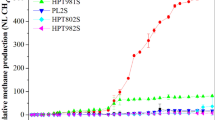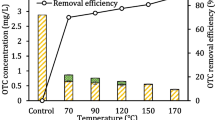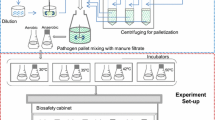Abstract
Hydrothermal carbonization (HTC), utilizing high temperature and pressure, has the potential to treat agricultural waste via inactivating pathogens, antibiotic resistance genes (ARG), and contaminants of emerging concern (CEC) in a environmental and economical manner. Livestock mortality is one facet of agricultural waste that can pose a threat to the surrounding environment. While several methods are utilized to treat livestock mortality, there remains a paucity of data on the elimination of microbially-derived DNA in these treatment practices. This DNA, most notably ARGs, if it survives treatment can be reintroduced in agricultural environments where it could potentially be passed to pathogens, posing a risk to animal and human populations. HTC treatments have been successfully utilized for the treatment of CECs, however very little is understood on how ARGs survive HTC treatment. This study aims to fill this knowledge gap by examining the survivability of microbially-derived DNA in the HTC treatment of livestock mortality. We examined three treatment temperatures (100°C, 150°C, and 200° C) at autogenic pressures at three treatment times (30, 60, and 240 min). We examined the amplification of a plasmid-borne reporter gene carried by Escherichia coli DH10B introduced to both beef bone and tissue. Results indicate that while all three temperatures, at all treatment times, were suitable for complete pathogen kill, only temperatures of 150°C and 200°C were sufficient for eliminating microbial DNA. These results serve as the basis for future potential HTC treatment recommendations for livestock mortality when considering the elimination of pathogens and ARGs.

Similar content being viewed by others
References
Sander J E, Warbington M C, Myers L M. Selected methods of animal carcass disposal. Journal of the American Veterinary Medical Association, 2002, 220(7): 1003–1005
Kim H S, Kim K. Microbial and chemical contamination of groundwater around livestock mortality burial sites in Korea: A review. Geosciences Journal, 2012, 16(4): 479–489
McLaughlin M R, Brooks J P, Adeli A, Miles D M. Using broiler litter and swine manure lagoon effluent in sawdust-based swine mortality composts: Effects on nutrients, bacteria, and gaseous emissions. Science of the Total Environment, 2015, 532: 265–280
Libra J A, Ro K S, Kammann C, Funke A, Berge N D, Neubauer Y, Titirici M M, Fühner C, Bens O, Kern J, Emmerich K H. Hydrothermal carbonization of biomass residuals: A comparative review of the chemistry, processes and applications of wet and dry pyrolysis. Biofuels, 2011, 2(1): 71–106
Rizzo L, Manaia C, Merlin C, Schwartz T, Dagot C, Ploy M C, Michael I, Fatta-Kassinos D. Urban wastewater treatment plants as hotspots for antibiotic resistant bacteria and genes spread into the environment: A review. Science of the Total Environment, 2013, 447: 345–360
Nielsen K M, Johnsen P J, Bensasson D, Daffonchio D. Release and persistence of extracellular DNA in the environment. Environmental Biosafety Research, 2007, 6(1–2): 37–53
Singer R S, Williams-Nguyen J. Human health impacts of antibiotic use in agriculture: A push for improved causal inference. Current Opinion in Microbiology, 2014, 19: 1–8
Berge N D, Ro K S, Mao J, Flora J R, Chappell M A, Bae S. Hydrothermal carbonization of municipal waste streams. Environmental Science & Technology, 2011, 45(13): 5696–5703
Oliveira I, Blohse D, Ramke H G. Hydrothermal carbonization of agricultural residues. Bioresource Technology, 2013, 142: 138–146
Ro K S, Novak J M, Johnson M G, Szogi A A, Libra J A, Spokas K A, Bae S. Leachate water quality of soils amended with different swine manure-based amendments. Chemosphere, 2016, 142: 92–99
Sun K, Kang MJ, Ro K S, Libra J A, Zhao Y, Xing B S. Variation in sorption of propiconazole with biochars: The effect of temperature, mineral, molecular structure, and nano-porosity. Chemosphere, 2016, 142: 56–63
Sun K, Ro K, Guo M X, Novak J, Mashayekhi H, Xing B S. Sorption of bisphenol a, 17 alpha-ethinyl estradiol and phenanthrene on thermally and hydrothermally produced biochars. Bioresource Technology, 2011, 102(10): 5757–5763
Changi S M, Faeth J L, Mo N, Savage P E. Hydrothermal reactions of biomolecules relevant for microalgae liquefaction. Industrial & Engineering Chemistry Research, 2015, 54(47): 11733–11758
Suyama T, Kawaharasaki M. Decomposition of waste DNA with extended autoclaving under unsaturated steam. BioTechniques, 2013, 55(6): 296–299
Ducey T F, Shriner A D, Hunt P G. Nitrification and denitrification gene abundances in swine wastewater anaerobic lagoons. Journal of Environmental Quality, 2011, 40(2): 610–619
Lee C L, Ow D S, Oh S K. Quantitative real-time polymerase chain reaction for determination of plasmid copy number in bacteria. Journal of Microbiological Methods, 2006, 65(2): 258–267
Woody J M, Walsh R A, Doores S, Henning W R, Wilson R A, Knabel S J. Role of bacterial association and penetration on destruction of Escherichia coli O157:H7 in beef tissue by high pH. Journal of Food Protection, 2000, 63(1): 3–11
Rahn O. Physical methods of sterilization of microorganisms. Bacteriological Reviews, 1945, 9(1): 1–47
Liao C H, Shollenberger L M. Survivability and long-term preservation of bacteria in water and in phosphate-buffered saline. Letters in Applied Microbiology, 2003, 37(1): 45–50
Greer S, Zamenhof S. Studies on depurination of DNA by heat. Journal of Molecular Biology, 1962, 4(3): 123–141
Nicholson W L, Munakata N, Horneck G, Melosh H J, Setlow P. Resistance of Bacillus endospores to extreme terrestrial and extraterrestrial environments. Microbiology and Molecular Biology Reviews, 2000, 64(3): 548–572
Leclercq S O, Wang C, Sui Z, Wu H, Zhu B, Deng Y, Feng J. A multi-player game: Species of Clostridium, Acinetobacter, and Pseudomonas are responsible for the persistence of antibiotic resistance genes in manure-treated soils. Environmental Microbiology, 2016, 18(10): 3494–3508
Liu Y Y, Wang Y, Walsh T R, Yi L X, Zhang R, Spencer J, Doi Y, Tian G B, Dong B L, Huang X H, Yu L F, Gu D X, Ren H W, Chen X J, Lv L C, He D D, Zhou H W, Liang Z S, Liu J H, Shen J Z. Emergence of plasmid-mediated colistin resistance mechanism MCR-1 in animals and human beings in China: A microbiological and molecular biological study. Lancet Infectious Diseases, 2016, 16(2): 161–168
Perreten V, Strauss C, Collaud A, Gerber D. Colistin resistance gene MCR-1 in avian pathogenic Escherichia coli in South Africa. Antimicrobial Agents and Chemotherapy, 2016, 60(7): 4414–4415
Considine K M, Kelly A L, Fitzgerald G F, Hill C, Sleator R D. High-pressure processing- Effects on microbial food safety and food quality. FEMS Microbiology Letters, 2008, 281(1): 1–9
Taylor D M. Inactivation of prions by physical and chemical means. Journal of Hospital Infection, 1999, 43(Suppl): S69–S76
Brown P, Cardone F, Meyer R, Pocchiari M. High-pressure inactivation of transmissible spongiform encephalopathy agents (prions) in processed meats: Principles, technology, and applications. In: Balasubramaniam V M, Barbosa-Canovas G V, Lelieveld H L M, eds. High pressure processing of food. New York, N.Y.: Springer, 2016, 317–330
Taylor D. Inactivation of the BSE agent. Comptes Rendus Biologies, 2002, 325(1): 75–76
Verbyla ME, Mihelcic J R. A review of virus removal in wastewater treatment pond systems. Water Research, 2015, 71: 107–124
Wilkinson K G. The biosecurity of on-farm mortality composting. Journal of Applied Microbiology, 2007, 102(3): 609–618
Glanville T D, Ahn H, Akdeniz N, Crawford B P, Koziel J A. Performance of a plastic-wrapped composting system for biosecure emergency disposal of disease-related swine mortalities. Waste Management (New York, N.Y.), 2016, 48: 483–491
Bagge E, Sahlstrom L, Albihn A. The effect of hygienic treatment on the microbial flora of biowaste at biogas plants. Water Research, 2005, 39(20): 4879–4886
Guardabassi L, Dalsgaard A, Sobsey M. Occurrence and survival of viruses in composted human faeces. Danish Environmental Protection Agency, Sustainable Urban Renewal and Wastewater Treatment, Report No. 32, 2003, 1–58
Laxminarayan R, Van Boeckel T, Teillant A. The economic costs of withdrawing antimicrobial growth promoters from the livestock sector. OECD Food, Agriculture, and Fisheries Papers No. 78. Paris, France: OECD Publishing, 2015, 1–41
Durso LM, Cook K L. Impacts of antibiotic use in agriculture: What are the benefits and risks? Current Opinion in Microbiology, 2014, 19: 37–44
You Y, Silbergeld E K. Learning from agriculture: Understanding low-dose antimicrobials as drivers of resistome expansion. Frontiers in Microbiology, 2014, 5(284): 1–10
Sharma V K, Johnson N, Cizmas L, McDonald T J, Kim H. A review of the influence of treatment strategies on antibiotic resistant bacteria and antibiotic resistance genes. Chemosphere, 2016, 150: 702–714
Prasse C, Stalter D, Schulte-Oehlmann U, Oehlmann J, Ternes T A. Spoilt for choice: A critical review on the chemical and biological assessment of current wastewater treatment technologies. Water Research, 2015, 87: 237–270
Acknowledgments
The authors would like to thank Mel Johnson, Christopher Donaldson, and Hannah Rushmiller for their technical expertise.
Author information
Authors and Affiliations
Corresponding author
Rights and permissions
About this article
Cite this article
Ducey, T.F., Collins, J.C., Ro, K.S. et al. Hydrothermal carbonization of livestock mortality for the reduction of pathogens and microbially-derived DNA. Front. Environ. Sci. Eng. 11, 9 (2017). https://doi.org/10.1007/s11783-017-0930-x
Received:
Revised:
Accepted:
Published:
DOI: https://doi.org/10.1007/s11783-017-0930-x




